In the Moment:
Michael Frye's Landscape Photography Blog
by Michael Frye | Dec 14, 2011 | Advanced Techniques
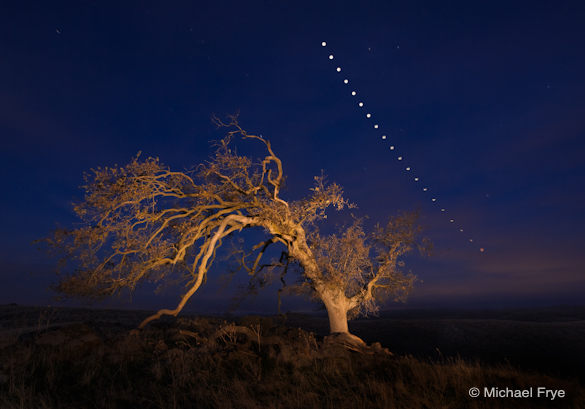
Oak tree and lunar eclipse sequence, December 10th, 2011
For me the hardest part about photographing last Saturday morning’s lunar eclipse was finding a good location. The fully-eclipsed moon would be close to the horizon in the west-northwest, so I needed a clear view in that direction, ideally with an interesting object in the foreground.
No place in Yosemite seemed to fit—too many mountains in the way. But I thought a remote region of western Mariposa County, with rolling hills and scattered oaks, might work. A week before the eclipse I scouted this area and found a photogenic oak tree on top of hill that seemed to line up with the projected path of the eclipse.
Friday night my student Erik and I got a couple hours of sleep, drove out to this spot, hiked up the hill, set up our cameras, and started our interval timers to capture a sequence of moon images ten minutes apart. We had a long wait, but it wasn’t too cold, and we enjoyed our peaceful, moonlit surroundings. A pair of great-horned owls serenaded us, and groups of coyotes howled at regular intervals. At one point Erik watched four coyotes climb a nearby moonlit hill, then saw one of them stop and howl.
(more…)
by Michael Frye | Dec 7, 2011 | Announcements, Reviews
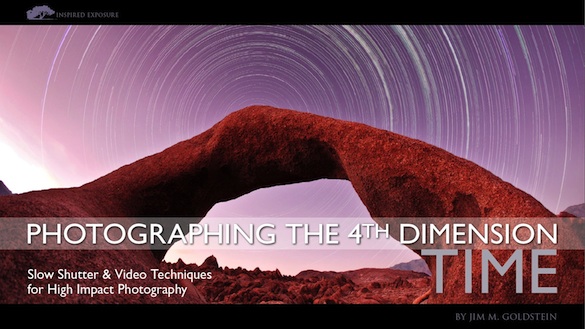
Jim Goldstein has just released a new eBook called Photographing the 4th Dimension – Time. In the book Jim describes seven different slow shutter speed and video techniques for making more creative photographs—including long exposures, light-painting, star trails, time-lapse, and cinemagraphs.
This book is a great way to delve into some new, fun, and creative aspects of photography. If you’ve never tried photographing star trails, making time-lapse videos, or creating cinemagraphs, Jim makes it easy to get started by giving you step-by-step instructions, sometimes including video tutorials.
Just browsing through the book can inspire you to try some new techniques and give your photography a creative kick in the pants. Personally I was intrigued by the cinemagraphs, where part of a still photograph is animated. Some cinemagraphs I’d seen before looked rather cheesy, but after viewing some of the examples here I realize that they can be done subtly, and beautifully, so I’m eager to try them—and it’s nice to have Jim’s detailed instructions for doing so.
(more…)
by Michael Frye | Dec 5, 2011 | Advanced Techniques, Photography Tips
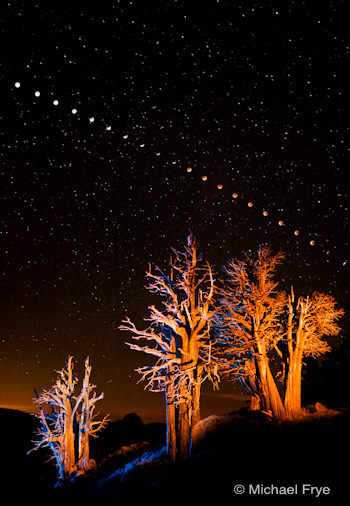
Lunar Eclipse Sequence, 1:23 a.m. to 4:49 a.m., August 28, 2007
Before getting to the topic at hand, I want to let you know that eight people have signed up for the Eastern Sierra Fall Color Workshop since I announced it last Thursday. The limit is twelve students, and I’m sure it will fill up soon, so if you’re thinking about signing up don’t procrastinate!
Okay, on to the eclipse. Before dawn this Saturday, December 10th, viewers in the Western U.S. and Canada will be able to see a total lunar eclipse. If you live in the eastern half of the U.S. unfortunately you’ll only be able to see a partial eclipse. People in most of Europe, Asia, and Australia will also be able to see a total eclipse, though in Europe it will be visible at moonrise on Saturday evening. This NASA page shows where the eclipse will be visible throughout the world, and this page shows more detail for western North America.
Moon Position
If the weather cooperates, and you want to try make your own eclipse photographs, here are some tips. (I’ve copied some of this from my post a year ago, but the information about the moon position is all new.)
(more…)
by Michael Frye | Dec 2, 2011 | Announcements
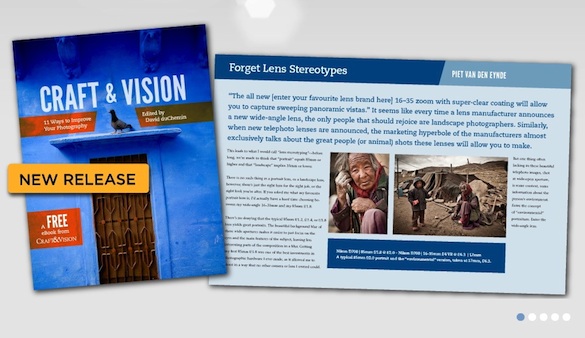
Craft & Vision has just released a new eBook called, appropriately, Craft & Vision: 11 Ways to Improve Your Photography. The book includes eleven different articles, including Tame Your Digital Exposures, by David duChemin, The Power of the Moment, by Eli Reinholdtsen, Slow Down and Learn to See, by Stuart Sipahigil, and Learn to Direct the Eye, by Yours Truly.
And best of all, it’s free—zero dollars, now and forever. You can download your copy here. And tell your friends!
by Michael Frye | Dec 1, 2011 | Announcements, Workshops
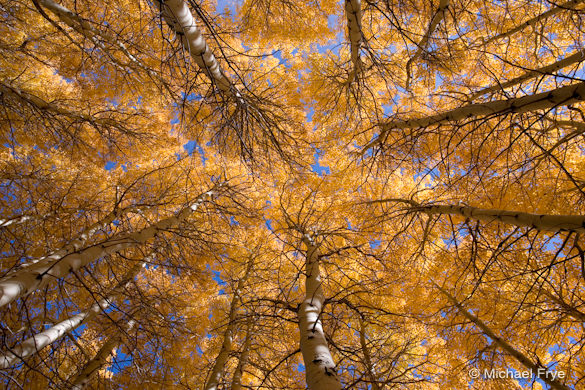
Aspen circle, June Lake Loop
Eastern Sierra Fall Color: Composition and Creativity Among the Aspens
October 18 (eve.) – 21, 2012
Is an eye for composition something you’re born with, or can it be taught—and learned?
The technical aspects of photography are pretty concrete. With a little instruction anyone can learn to read a histogram or control depth of field. But composition, creativity, and seeing are more nebulous. The infinitely varied world we photograph doesn’t lend itself easily to compositional rules and formulas. There’s a reason no one has yet developed an app that tells you when you’ve framed a good photograph!
I used to think an eye for composition was innate, but over the years I’ve changed my mind. I’ve seen my own compositional skills improve with time, but more importantly, I’ve watched many students—even some who thought they lacked that innate ability to “see”—grow and develop their sense of design, sometimes in great leaps. Composition can be taught, and learned by anyone. And no matter how long you’ve been making photographs you can always learn more.
(more…)













